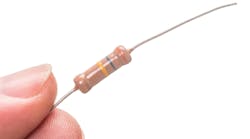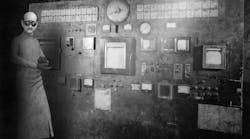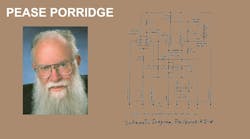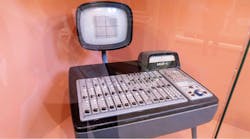In March of 1992, I went with Frank Goodenough (now deceased) of Electronic Design magazine to interview Loebe Julie of Julie Research Labs. Then, Julie was at his old offices on 26th Street in New York City. We really went just to visit, but we asked a lot of questions about "how things used to be" and "how things got the way they are." Fortunately, I brought along my little camcorder, and we recorded about 2 1/2 hours of conversations.
Mr. Julie was, even then, an old-timer. I remember his company as being a staid, conservative company selling high-precision, high-quality resistors back in 1970 when I first did business with them. And here it was over 20 years later.
Parenthetically, I should explain that Julie Research Laboratories has been making some of the world's BEST resistors since the 1950s. Mr. Julie himself is the holder of some 30-plus U.S. Patents, mostly on the design and manufacture of ultra-precision, ultra-stable (1 ppm) wirewound resistors—as well as 1-ppm-accurate dc standards and calibration instruments. (I bought a lot of Julie's 1- and 10-, 0.005% wirewound resistors in four-wire configuration to put in some precision measurement systems. I am sure they are within spec to this day.)
Since Frank and I had always worked a lot with operational amplifiers, we asked Mr. Julie what he could tell us about the early days of op amps. Julie explained that in 1941, he was hired by Professor Louis Ragazzini at Columbia University, New York, N.Y., to do research on analog computers and operational amplifiers. At that time, there was much interest in research for automatically aimed anti-aircraft guns. The war in Europe was in full swing, and the British military forces had a great need for a gun-aiming apparatus (a "Gun Director") that could shoot down enemy bombers. The U.S. Army was very interested in this, just in case the U.S. came into the war. (The U.S. Army also was interested in high-accuracy navigational aids for bombing enemy targets using first-generation guided missiles. But that came rather later....)
The tacit situation—a whole family of vital military secrets—was that a radar had been developed that permitted the U.S. and British ground forces to read the position and elevation of enemy aircraft. If a Gun Director could be made to use this information and aim the guns automatically, enemy planes could be shot down without anybody ever seeing them. Since many bomber attacks came at night or in bad weather, this was quite important. Of course, a computer would be needed—a fast electronic analog computer.
In those days, George A. Philbrick was a researcher in analog computers that used operational amplifiers. He believed that he could build a Gun Director that could automatically aim the guns, given the basic information. It would just have to LEAD the incoming planes by the proper amount. George had done a lot of study on this.
In those days, operational amplifiers did exist. But they were extremely large, bulky, and SLOW. They needed six or more vacuum tubes, and at least three regulated power supplies (+300, -250, and -400 V dc). That's not to mention about 20 W of heater power. And they had a frequency response of about 10 Hz. They had high dc gain, but were stabilized with very heavy damping. Thus, they were perfectly suitable for laboratory research and slow analog computers. But they were NOT good at all for real-time computing. I have tried to find out the schematic diagram for these older operational amplifiers, but haven't yet been able to get one. Maybe later.
Loebe Julie, a young electrical engineer of 22, had recently graduated from the College of the City of New York. He thought he could design an operational amplifier that would be a lot smaller, a LOT faster, and with much less power-supply needs. And he believed he could design it quickly, and it would be easy to manufacture after it proved useful. Professor Ragazzini was very negative, and didn't want Julie to try it. But there was a great need for this, as the U.S. could see the clouds of war approaching. Loebe told us that Philbrick, who had some authority and reputation in the field, intervened because he really needed this improved operational amplifier. And off they went.
Julie designed and built a simple, compact (3-in. by 4-in. by 7-in.), modular operational amplifier using two twin triodes similar to the 6SL7GT (which is a high-mu triode similar to the 12AX7). The first stage was differential with balanced plate loads. The output of that stage was coupled through resistive level changers down to the grids of the balanced (differential) second stage at -150 V. The output of the second stage was plate-loaded, and could swing ±75 V. I'll show you the schematic in a future column. And there will be some interesting stuff on what's involved in trying to design a tube op amp nowadays.
The damping was fairly light, and a well-behaved gain-bandwidth product of about 100 kHz resulted. While 100 kHz doesn't sound like a lot, note that in real time, the small-signal step response of a unity-gain inverter could be as quick as 5 µs. So this quick amplifier was the heart of the modern high-speed analog computer. And its power-supply requirements were quite modest, just + and -300 V at 10 mA, plus 5 W of heater power. Consequently, the power supply for a large array of operational amplifiers could be quite small and simple.
A batch of 50 copies of Julie's prototype amplifiers, assembled on little aluminum brackets, was wired up quickly. A set of six was provided to the Analog Computer section. In a short time, the M-9 Gun Director was completed and tested. Its demonstrations worked very well, and it was rushed into production. When the M-9 was put into service in England and connected to the system of radar receivers and the anti-aircraft guns, it was quickly put to the test.
When enemy bombers were detected approaching through heavy clouds, the M-9 automatically aimed and fired off the guns. To the amazement of many and the delight of all, enemy bombers began falling out of the clouds! Needless to say, the priority for getting the M-9 Gun Directors into service was redoubled.
After the war, Ragazzini published a paper (Proc. IRE about 1946) explaining how HE had designed the operational amplifiers. In the paper, he took most of the credit for many of the ideas in the M-9 Gun Director. Mr. Julie's name was listed among the contributors, but no proper credit was given. Alas! Publishing procedures and credits for contributors have changed since then—but just a little!
Meanwhile, Philbrick got many of Julie's ideas (which Julie had put in the analog computer) from Henry Paynter. These were amplifier applications circuits for high-speed summing and integrating, as well as the design of stable differentiators. So Mr. Julie must be credited as a major contributor to the invention of the modern high-speed analog computer.
I have seen a picture in the book by Robert Buderi, The Invention that Changed the World. This excellent 588-page book explains how radar was extremely valuable in offsetting the military strength of the Axis powers and winning the war. There is a sketch of an M-9 Gun Director on page 133, and some mention of its schedule of completion in late 1942 on pages 132-134.
As the design of the M-9 was outside the purview of that book, no mention was made of Loebe Julie or George Philbrick. But photographs of the M-9 Gun Director show a heavy oblong assemblage enclosed in a heavy metal military-type housing perhaps 3 ft. by 4 ft. by 6 ft.—all on a four-wheel trailer. How many op amps inside? Perhaps a dozen? The original design, as implemented at Columbia, was much more compact. But the fact that it really worked, after all necessary militarization, was nothing short of miraculous.
I recently read a good book by G. Pascal Zachary, Endless Frontier—Engineer of the American Century. The book's all about Vannevar Bush, who was the director of the National Defense Research Council (NDRC) during World War II. Was there much more information in this book on the M-9 and its design? Not really in detail. But on page 135, it talks about, "...February 1941, when physicists had begun to build gunlaying radar whose aim was to automate the tracking of enemy targets. Once picked up on the radar screen, the target would be tracked automatically and the necessary information fed into the anti-aircraft gun."
If this wasn't incredible enough, the device would automatically aim the gun, too. At the end of May, the tracking system was demonstrated on an airplane (flying overhead). And in December (1941) a truck-mounted system was shown off. Adopted by the Army, the system, dubbed SCR-584, was used virtually unchanged throughout the war.43 (Rigden pp. 133-145.)." The M-9 was the heart of the SCR-584 system.
Mr. Julie believes that much of that paragraph by Zachary was correct. But he recalls very well that this work started after Pearl Harbor, in Dec. 1941. The actual time of development was probably a year LATER than the schedule listed by Zachary. This is then in good agreement with the timetable listed in the Buderi book.
After the war, Philbrick took the basic Julie operational-amplifier design and revised and developed it into the familiar "K2-W" operational amplifier, which he incorporated into many of his analog computers. The K2-W didn't have a differential second stage, but a single-ended second stage followed by a cathode-follower output buffer. But it had many features of the original Julie operational amplifier. So Julie still claims to be the inventor of the modern operational amplifier, and I believe the results bear out his claims.
After the war, Julie went into the business of manufacturing precision resistors, which are essential in many high-precision instruments. A major need for precision resistors was in inertial navigation. The specific accuracy of an inertial guidance system depends on the integrators. They tell you how fast you're going and how far you've gone. Integrators require excellent resistors.
Julie's best resistors went into the best inertial guidance systems—as needed for national security—in navigation systems for bombers and Inter-Continental Ballistic Missiles. In the 1950s, most "precision wirewound resistors" were not really very accurate or stable. They had barely 0.03% short- or long-term stability, due to improper manufacturing techniques, poor choice of materials, and stress sensitivity. Julie's patents teach many improvements in this art.
Julie Laboratory Standard resistors also went into large and precision electronic analog computers. They were used extensively in the 1-ppm precision voltage-measurement systems (potentiometers). These were used to calibrate the accuracy and confirm the performance of the early accelerometers and inertial guidance systems.
As Lord Kelvin stated 100 years ago, "When you can measure what you are speaking about, and express it in numbers, you know something about it..."* In many cases, imperfections and inaccuracies of inertial guidance systems weren't even noticed until high-accuracy measurements were made. Hughes Aircraft was buying some Julie equipment to confirm that some of the Hoffman Reference Diodes they were buying were holding better than 0.01% stability. Julie pointed out that many of the diodes were drifting more than 0.03% per day, a fact not previously known.
A recent book by John MacKenzie, Inventing Accuracy: A Historical Sociology of Nuclear Missile Guidance, covers many aspects of the design of inertial guidance systems from the 1940s to the present time. This book "talked all about accuracy." It talked all about the need for precision designs and components. It talked ALL AROUND the precision resistors. But it didn't go into the actual precision resistors, nor did it provide any mention of Julie's designs and patents or his essential contributions to the development of inertial guidance.
Fortunately, after I brought this unfortunate oversight to his attention, Mr. Julie is writing up notes to give some balance and insight into the importance of his precision resistors in the development of inertial guidance systems.
Since designing a large amount of precision automated test-and-measurement equipment in the 1980s, Mr. Julie has more recently been active in designing high-resolution (20-Mpixel by 12-bit by 3-color) computerized photographic-image editing systems. He has largely recovered from a stroke that slowed him down a couple of years ago. Shortly, we hope to see an exhibit of his work at the Smithsonian Institution, Washington, D.C.
So Loebe Julie is a spry old-timer, indeed! You can pronounce his name, "LOWB" (preferred)—or you could call him "LOW-BE"—either way is acceptable to Mr. Julie. Just don't call him late to supper.
All for now. / Comments invited!
RAP / Robert A. Pease / Engineer
[email protected]>or:
Mail Stop D2597A
National Semiconductor
P.O. Box 58090
Santa Clara, CA 95052-8090
* "When you can measure what you are speaking about, and express it in numbers, you know something about it; but when you cannot measure it, when you cannot express it in numbers, your knowledge is of a meager and unsatisfactory kind: it may be the beginning of knowledge, but you have scarcely, in your thoughts, advanced to the stage of science."—William Thomson, Lord Kelvin, 1824-1907.





